Top of the Foot Pain:
Gout On Top of Foot [Causes, Symptoms & BEST Home Treatment!]
Gout on top of the foot is possible. We go over the causes, symptoms & the 100% home remedies and the best treatment! So start fixing you gout pain TODAY!
Table of Contents
Gout on top of foot treatment video:
Treatment for gout flare-up in foot video summary:
🦶This video will go over the best gout natural remedy best gout natural treatment relief options shown by research in 2021!🦶
This is all evidence-based gout treatment with gout diet tips to help you STOP gout attacks in the big toe joint and the foot. We will go over gout symptoms and some great gout home treatment and home remedy options for your gout attack.
We will go over uric acid, natural treatments. We don’t focus on apple cider vinegar treatment as it is not really proven.
Immediate Gout Pain Relief:
These medications can help with pain relief, although there are no guarantees for immediate pain relief.












Can you get gout on the top of your foot?
We frequently hear, “can you get gout on top of your foot?” the answer is usually not.
Consider these more common causes of top-of-the-foot pain.
Gout is very rare to get on top of the foot.
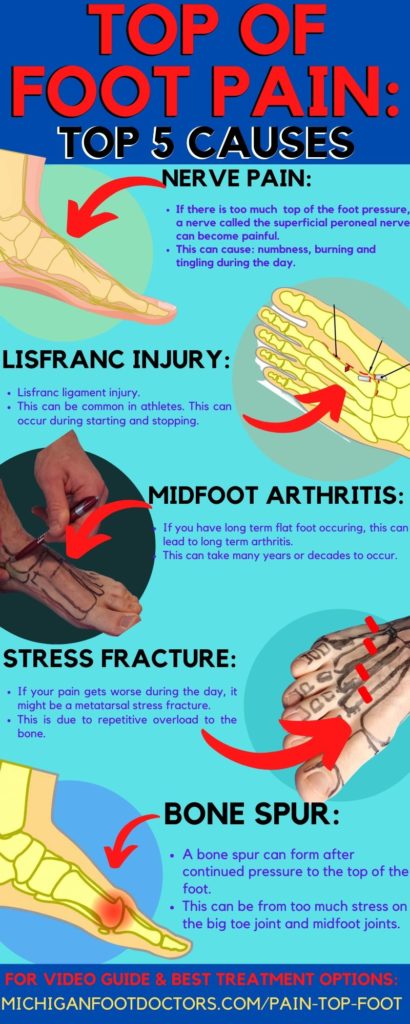
Top of the Foot Pain Picture Gallery:
The most common causes of top of the foot pain:
- Top of the foot nerve compression.
- A swollen top of the foot can also occur due to stress across the top of the foot.
- Lisfranc fracture or sprain.
- Sprained top of the foot.
- Top of the foot bone spur.
- Hallux rigidus or dorsal 1st metatarsal joint spur.
- Dorsal foot compression syndrome.
- Flat foot compression leading to osteoarthritis.
So, let’s look at the PICTURES!
Causes:
- Gout is caused by a compound called uric acid that builds up in your joints and foot.
- This can result in a rapid onset of pain.
- This usually lasts about 4 to 12 hours at its most severe, and then there is gradual pain afterward.
Can gout affect the top of your foot?
Almost all of the gout in the foot is on top of the big toe joint. In this way, it can radiate across the nerves up your foot, making it seem like it is affecting the top of the foot.
Yes, gout can affect the top of your foot. The most common areas of gout attacks are:
- Gout most commonly attacks the big toe joint.
- Over 50% of all gout attacks are in the big toe joint. In our opinion, it is even higher than this, especially the symptomatic gout attacks.
- This can usually happen on the top part of the front of the foot.
- The pain is so severe that it seems to radiate up the top of the foot, almost into the ankle.
- Gout can also occur in the small toes as a secondary site.
- Gout usually does not occur in the top and middle part of the foot unless you have prior arthritis. But it is common to have the pain radiate up to this site if the big toe is really throbbing.
- The skin is thinner on top of the foot, so some people feel the gout attack more here.
- You can also get gout under the foot, but this happens at the bottom of your big toe.
- The main way to know that it is gout is that it usually shows up quickly without a prior attack.
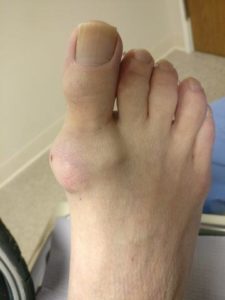
Consider a pinched nerve as an alternative to gout on the top of your foot.
Gout on top of your foot is usually not gout at all, based on what we see regularly.
- Gout-like pain on top of the foot is usually almost always irritation of the superficial peroneal nerve or the deep peroneal nerve.
- Consider treating this pinched or irritated nerve on top of your foot.
- If your gout attack is not usually in the big toe joint, it is likely something else.
Can you get gout on the side of the foot?
- Yes, you can get gout on the side of the foot. But it usually occurs on the inside of the foot, not the outside toward the 5th toe joint.
- If gout occurs in the smaller toes or even the 5th toe, it will look like the picture below.
- Gout can produce crystals known as tophi that cause you to get why cottage cheese-like formations are seen coming out of openings in your skin, just like the 5th toe picture of gout located below here.
- Gout usually occurs at the big toe joint.
- Gout in the big toe joint is also known as podagra.
- In this way, gout can be on top of your foot.
Consider possible nerve pain in the pinky toe as an alternative to gout pain on the side of the foot:
- Pain in the pinky toe is rarely gout.
- Don’t let gout be an innocent bystander to your 5th toe pain.
Can you get gout on the bottom of your foot?
- Yes, you can get gout on the bottom of your foot.
- If the pain is severe enough, it will radiate along the nerves along the bottom of the foot.
- The real key to knowing if it is gout is to check the symptoms: especially if it starts quickly.
- This once again usually occurs only at the big toe joint. If it is not the big toe joint, then you likely have a different problem than gout.
- Consider Plantar Fasciitis as an alternative to gout on the bottom of the foot.
Symptoms:
The main thing to know about gout is that it usually happens very quickly, usually without an initial injury:
- Gout attacks usually happen very quickly and are very severe with no apparent damage or injury.
- Intense joint pain in the first 12 hours of it starting.
- Consistent pain after the initial wave of pain goes away can last multiple days or even weeks.
- Serious inflammation and redness the first day.
- Almost not able to bend that particular foot joint.
- If this is chronic and continuous pain worsens for many days, then this likely is not gout at all.
- The majority of people that come into our clinic thinking they are gout are not actually gout.
- Gout can very easily be used to blame the pain that other injuries such as big toe joint arthritis are causing.
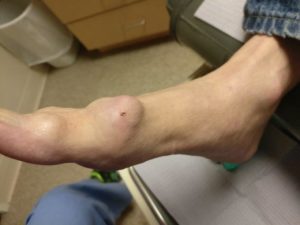
Gout Treatment:
The biggest problem with gout is severe pain!
Treatment Goal #1: Get to a podiatrist to confirm that it’s actually gout.
- Unless you have had previously confirmed gout attacks, the odds are you do not have gout.
Treatment Step #2: Get rid of the pain!
- I would not wish injecting steroids into someone’s big toe joint on my worst enemy! A steroid injection into the big toe joint can be excruciating.
- I would strongly recommend going with an oral steroid for severe pain vs. Colcrys oral tablets and anti-inflammatories for more moderate pain.
- These treatments can make your pain go away almost immediately.
- The goal is to get the pain to come down from about a 10/10 to about a 5/10 within the first 24 hours.
- After the first day, anti-inflammatories can work great in relieving the pain.
- At this point, elevating your foot and using ice regularly can make the rest of the pain go away quickly.
Treatment Step #3: Prevent the top of the foot gout pain from coming back!
- Gout can happen for many reasons in many different people.
- Basically, the healthier you are, the better you eat, the less gout you will have.
- If you are hydrating well, if your kidneys are working well, and if you can get into reasonable health, gout attacks should be fairly limited.
- If you do have a genetic reason or possibly a kidney issue, many medications are available to help with your gout pain.
- The most common medication in preventing frequent attacks is allopurinol. Fortunately, most people with gout attacks never get to this point where they need lifelong medication for their gout.
Treatment Step #4: Weigh the Pros and Cons of treating Foot Gout Long Term:
- Most people never need to take lifelong gout medication. There are many pros and cons to taking medication.
- Most gout attacks are not actually gout. We feel that gout is overrepresented, especially when it is really arthritis pain.
- If you do have frequent attacks every year, and it really is gout, many gout medications can be taken.
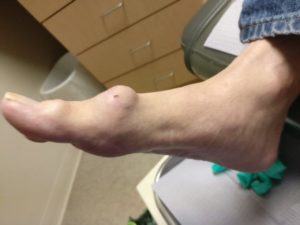
Best Home Treatment:
- There are some great all-natural supplements and treatments listed below.
- Just be aware that these supplements may be well-rated but do lack overall deep scientific evidence.
- Make sure to get your gout properly diagnosed by a podiatrist before administering any treatment at all!
- Gout is one of the most misdiagnosed conditions that we run into by patients.
Best Gout Supplements:
- Use these at your own risk, but they do have great reviews!
- The studies are not definitive on supplements, but people are very loyal to these.
- Please read the reviews on Amazon and give them a try.
- Just make sure to check with your podiatrist before taking any medications!








Wait it out:
- Take it easy that day, generally doing these things for 1-2 days will start to feel better.
- See your podiatrist as soon as possible for steroids or Indomethacin if possible.
- Make sure it’s not a different problem as well!
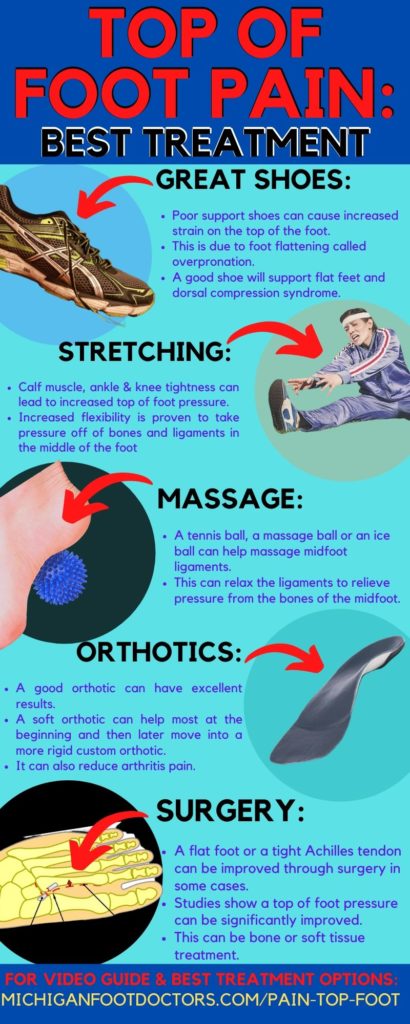
Top of the Foot Home Treatment:
- There are usually two phases to treating the top of the foot pain treatment.
- This doesn’t matter whether it’s an intermittent sharp pain on top of the foot, pain on top of the foot near toes, tendonitis on top of the foot, or a top of the foot bone spur. Treatment is all roughly very similar.
- The two phases of treatment include controlling the acute inflammation and correcting the biomechanics, which led to the problem in the first place.
- Great top-of-the-foot shoes and great orthotics lead to the prevention of dorsal compression syndrome. This prevents compression on top of the foot. It prevents the stretching on the bottom of the foot.
- This will also reduce your numbness, burning, and tingling pain.
Control Inflammation:
Massage & Ice Products:
- The metal ball is one of my personal favorites.
- This can work well for a bruised top of the foot.
- This is not a permanent solution. You still need to remove the stress off of the top of the foot.






Menthol Based Gels:
- Biofreeze is one of our favorites.
- These gels have been studied to work 2x as long as ice.
- This can also work as a great option for a bruised top of the foot or top of the foot extensor tendonitis.
- This is not a permanent solution. You still need to remove the stress off of the top of the foot.








Massage Sticks:
- These can work great for loosening your muscles.
- This allows less tightness and pressure on the ball of your foot.
- This works best for extensor tendonitis on the top of the foot.






Removing The Stress:
- The key is to prevent future pain.
- If you can get rid of the pain and swelling, this will let you start walking normally.
- If you can walk normally, the vast majority of your pain should gradually start to go away.
- This will limit dorsal compression syndrome and limit extensor tendonitis to the top of the foot.
Best Top of the Foot Pain Shoes:
- Getting a great supportive pair of shoes will ensure that pressure is removed from the top of the foot.
- There is much less compression appreciated.
- This is especially important if you have a swollen top of your foot, intermittent sharp pain on top of your foot, and top of the foot compression.
- Consider shoes combined with a good supportive orthotic for the best pain relief!
- The following link will show you what our favorites are.
The Best Top of the Foot Pain Orthotics:
- These are our recommended orthotics.
- There are different types of different shoes.
- Women’s shoes usually need a less bulky orthotic but allow for less correction.
- A full-length orthotic requires a running shoe, boot, or comfortable walking/dress shoe.
Best Full-Length Orthotics:








Best Dress Shoe Orthotics:






Best 3/4 Length Orthotics:


Get A Great Dynamic Stretch:
- It is possible to stretch on your own, but these products can also really help!
- This will take pressure off of the ball of your foot.








Get A Great Static Stretch:
- These devices are great for stretching while you are resting.
- This will also help take pressure off of the ball of your foot.






Top of the Foot Pain Trauma:
- If you have a sprain Of the foot, Lisfranc fracture, or a fracture to the top of the foot, you need to protect it.
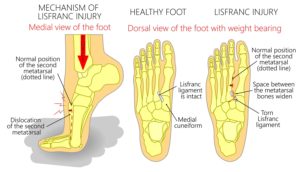
- The recommended way of doing this is to offload with a good supportive boot or cast.
- The best way to do this is, of course, to see your podiatrist and get evaluated with an x-ray, ultrasound, and potentially even an MRI or CT scan.
- If you cannot do so, it may benefit you to be in a cast, fractured boot, or even keep the weight off of it with a rolling knee scooter or other protective devices.
- We as podiatrists frequently take patients off work for a very long period of time when they suffer a traumatic injury. Unfortunately, there is no other way around us in labor jobs.
- If you have a sit-down job, there are ways to get people back to work quicker, but this can be impossible otherwise.
Top of the Foot Fracture Boot Treatment:
- There are pros and cons to using a boot to treat your foot pain. The pros are that your injured heel will hopefully have a chance to heal gradually! If you are immobilized too long, the cons are that you will gradually become stiff and overworked to your other leg. r
- Our favorite fracture boots and their supplies:








Offloading and Scooter treatment:
- These are favorite knee scooters and walking devices.
- If your Achilles tendonitis pain is severe, offloading can be very effective until the pain calms down.








Top of the Foot Pain:

